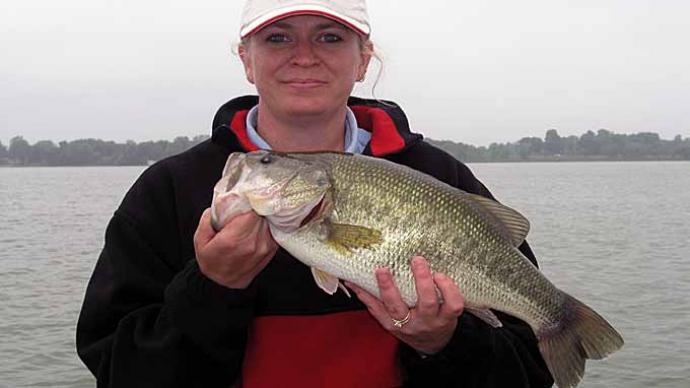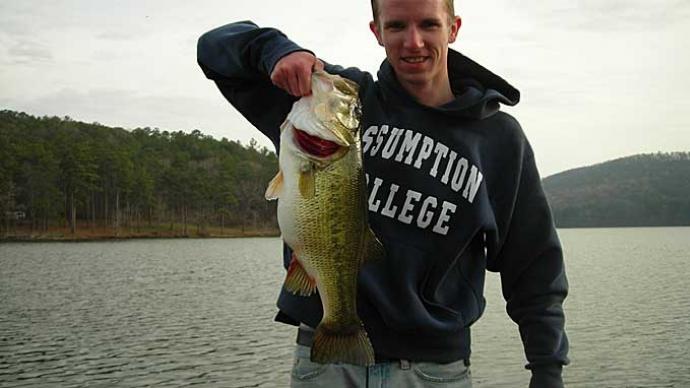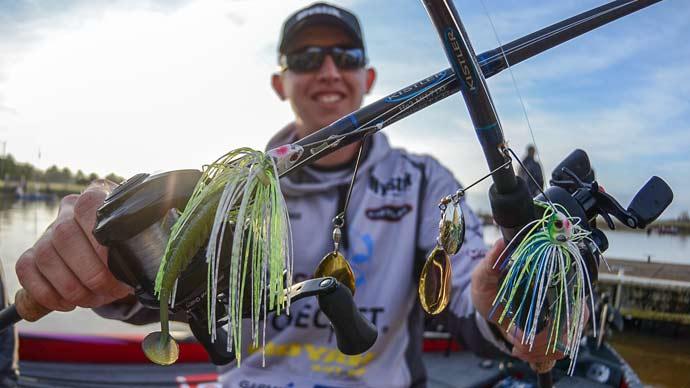
I started by letting you fill in the blank because there are all sorts of right answers. Maybe one first needs to figure out when it is spring. Since I like hot weather I would like to pretend spring is on its way after the second severe cold front. However there are often some indicators which should make you think about spring.
To begin with once you pass the winter equinox (the shortest day of the year), things are going in the right direction. Sure cold weather and water usually mean that fish will be in winter patterns through January and into early February, but watch out if suddenly you get several days of 70-degree weather even in the month of January. The fish, given such encouragement, move shallower in a hurry. Not all fish go and stick their heads in the mud in the winter, so such a warming trend may result in considerable numbers of bass shifting closer to true spring staging areas.
Another factor that can tend to keep bass in shallower areas are patches of vegetation (for those lakes lucky to have some). Vegetation growing close to channels or sharp drops, act like magnets for the bass and the fish will use any encouragement of impending spring to stratify into shallower water around or in vegetation.
So basically you have to start by deciding just how much the fish are really going to react to these conditions. There are some "givens" that you can hang your hat on concerning spring fishing. The first is that the bass are going to most likely be feeding on crayfish. If the water is still very cold even in the shallow protected coves, then you should use a slow moving bait that acts like a crayfish. If you do not know the reaction that a crayfish displays when facing a threat, then shame on you. At the risk of getting strange looks from trotliners, visit a bait shop and agitate the crayfish if you missed that lesson as a youngster. A crayfish jumps and then swims backward for a short distance.
Before you get ahead of me, let me state that 90 percent of the crawfish-colored baits have little in common with the action of a fleeing crayfish. But they are the right color and when bass are feeding color is important, even if the crayfish imitation is being worked at a rate that sets a new speed record for that obtained by the real thing.
Let's get back to the concept of using the action as a triggering factor in getting a bass to strike. If you watch a crayfish swim, you will recognize that the action is one that is very similar to that of a jig-and-pig. In other words, you are capable of making a jig-and-pig bounce on the lift and then flutter on the fall just as a bass sees the action when a crayfish is in an attempted retreat.
A few years ago a friend and I really had success using this action while fishing the deer stand and railroad tram area on Rayburn (Texas) in late January. This type of technique greatly out-fished any other action we could create with the jigs. It became evident why it worked when we began to look in the throat of some of the bass and saw pincers sticking out.
Who knows what a bass thinks when it sees a crawdad colored Rat-L-Trap zipping by at a rapid speed? But if the fish is really aggressive it does not seem to matter, they are just locked on the color. Any time of the year you can often get more strikes if you alternate the rate of retrieve.
However, during the spring, you really need to concentrate on varying your rate of retrieve so you can establish just how active the bass are in a given area.
The old fisherman's adage is usually correct in that when you see turtles sunning you can catch some bass shallow, even if it is in late January. Before I leave the crayfish let me point out a set of crankbaits that are in my opinion as close as any crankbait to being a crayfish imitator. These are the wide-lip cranks such as the Mud Bug. Any crankbait that has a wide lip also has a wide wiggle and a tendency to move more slowly on retrieve than a fast-wiggle type of crank. Again the action is closer to the swimming action of a fleeing crayfish.
My favorite bait for working bass in the spring is a spinnerbait. Note I did not say what stage of spring because it really doesn't make a difference since the spinnerbait is just that versatile. I have caught a bunch of bass on spinners in mid-January over moss at Fork (Texas). In that case the fish had migrated to the moss from a deeper drop, which was 30 or so yards away. How did I know that, asked the "smarty" in the back of the room. Well for one reason, prior to the warm up I had been catching fish in deeper water on jig-and-pigs. Likewise for several early springs the folks fishing major tournaments on Rayburn have been using large blade spinners with a technique called slow rolling. What this actually means is that you can use a spinner to establish a pattern by working the same bait in shallows and by slowing the rate of retrieve. Work the bottom in deeper water or, if you choose, on the actual bottom of channels.
When the water actually begins to warm you should have a much easier time finding reproducible patterns. As I pointed out a few articles ago, your temperature gauge is most helpful in sorting out which part of the lake is warming first. You can bet that all the fish want to move to the shallower parts of their territory, but more fish will be in the shallower water in the areas that warm first.
Since these are reproducible factors, you should consistently recognize you need to fish deeper in the cooler areas even if you are using the same bait.
Another factor that comes into play during the period when the water is actually becoming warm is that the highest percentage of bass in the shallowest water will be the smallest in size. In other words the buck, or male, bass will tend to populate the shallower parts of the area in greater numbers with the larger bass particularly the females being slower to edge to the shallower strata. The result of this fact is that many folks sit on the area they should be fishing and cast into shallower water, which is preferentially populated by smaller fish.
A few years ago Lake Fork came up in the late spring and folks, including guides, were having a tough time catching fish. But one guide was consistently having success. It ended up that he was fishing five to eight feet deeper than most of the other folks. The lake came up but the fish, particularly the larger ones, simply did not go back to the newly flooded areas. This is very contradictory to what most of us who grew up in Texas fishing Raybum and Toledo Bend expected. On those lakes where there is flooded buck brush in the spring, you can be sure the cover means expanded areas of prime bass habitat. The one time during the spring that flooded brush tends to be a dud in its effectiveness to hold bass is when there is a sudden release of water from the lake. The fish tend to back out of flooded areas when they sense a lowering of the level is occurring.
One of the rituals of fishing in the spring, particularly when the water has warmed, is working the flooded buck brush or other vegetation. A jillion fish have been caught on Red Fin, or Rogue type swimming baits fished adjacent to such areas. Actually if you want to use a bait with the same general swimming action, but one that is much less likely to hang up, then try a Scout. This was the bait originally called the Spence Scout, but now marketed by the Strike King company as a Scout. The bait has a lip which gives it a rather slow wiggle and a skirt which adds even more attraction to its fish appeal. For a while the bait was not available, but it is so good for working through brush, or even over vegetation, that I found a friend who did wood working and had him lathe some bodies and I recycled the metal lips and other parts to enable me to continue to have these great spring producers.
The advent of the soft plastic jerkbaits such as a Slug-Go or Bass Assassin offer a weedless version of the same action that a Red Fin or Rogue has except without the tendency to hang up on brush or weeds. The colors are as limitless as your imagination. However, if I had to hang my hat on a reproducible selection I would have some in shad or minnow color as well as chartreuse (bream) color.
I have already mentioned jig-and-pig baits, but not in the sense of fishing flooded brush. These baits work great crashing through the small sticks and dropping straight down in the thick stuff. Why will a bass be in such cover? To begin with, bass are cover-relating creatures when given the chance. However if you think about it, most trees or shrubs have thick growth at the upper parts and actually have open areas next to the ground. In the case of bass, the flooded stuff offers both protection from sunlight and a place where new types of food lurks. And it can be approached from under the canopy in relatively open swimming areas. The fisherman has another problem in that if the bait goes in to the thickest part, it - and hopefully the fish - have to come out in close to the same area. So it goes without saying, you have to use sufficiently tough line to withstand the wear and tear of the thick stuff as well control the fish and horse it out of the cover.
A crawworm, used as either a trailer on a jig or with a pegged bullet lead in a Texas style rig, gives both good action as well as a weedless presentation. In late spring, a pumpkinseed color crawworm is often a great producer. If you add some additional color contrast such as blue or chartreuse pincers, you can sometimes even increase its productiveness. The pumpkinseed color is very close to a soft-shell crayfish and they often have a small amount of contrast color.
As the water warms, everything that spawns, or has an impending hatch, moves into the shallows to breed and produce young. Bass are opportunistic feeders. In other words they may feed on one food source most of the year but if there is an abundance of another food source at a particular part of the lake during a particular time of the year, they are not above working over the easy pickings when available. The hatch of frog eggs and their development into tadpoles as well as the availability of large numbers of small amphibians can create feeding frenzies for periods of time.
Obviously plastic lizards and worms are always good baits, but in the spring they allow you to mimic a wide array of food sources - which may just be populating the shallows in good numbers. The other thing about a plastic lizard is these baits represent a real live critter that bass both like to eat and apparently find as a threat to nests or potential threats in nesting areas. Real lizards come in all sorts of colors. However I believe that bass are, in the case of artificial lizards, more interested in the action. The color probably comes into play as simply a contrast which allows the bass to detect the image easier.
Bass at times like a noise presentation however if they are in less than four feet of water a more subtle presentation is often preferable. This is particularly true when fishing soft plastics that are being cast to visible cover. It is important you learn how to "flip" in order to present the bait with a soft entry and also with the greatest possible accuracy since the strike zone may at times be fairly small around the tight cover.
You can get badly fooled in the spring by assuming that feeding bass are in a given depth and stay focused on that depth in all of your fishing presentations. You need to force yourself to experiment in fishing variations of depths and with various types of presentations. Sure you may have to deal with the "why in the heck are they here?" But after all, working out the riddle of finding bass and enticing them to hit is what it is all about. Don't get caught up in trying to make them be where you want them to be and only hitting what you want them to hit. Bass are versatile and you have to be the same to succeed in spring fishing.




